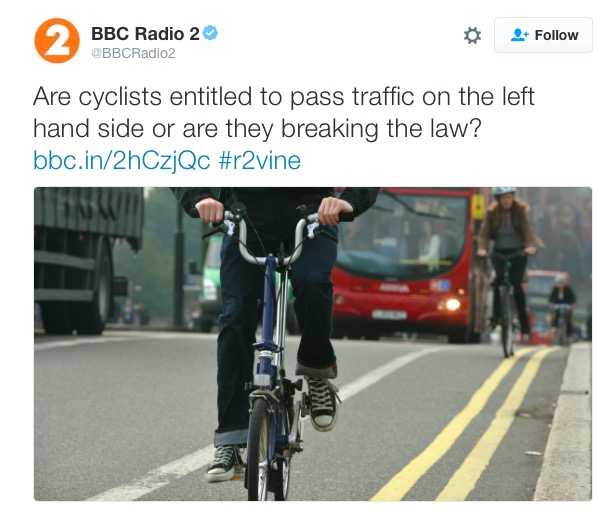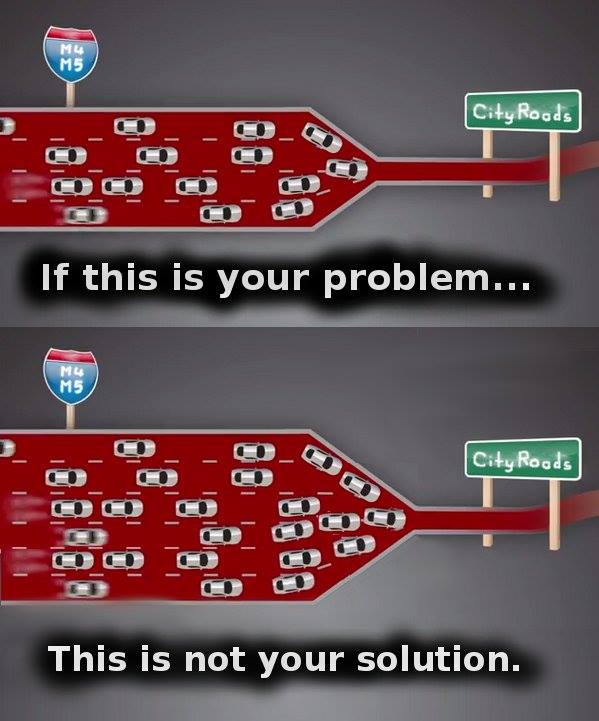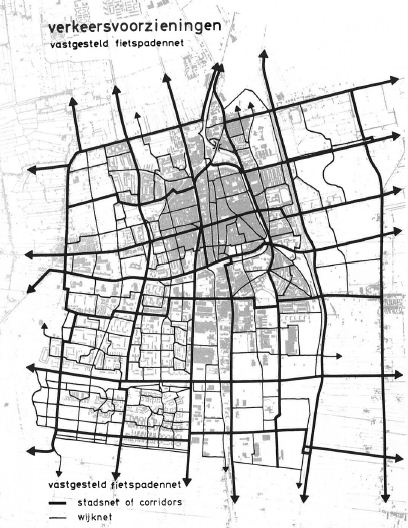An exercise I’ve been planning for a while is to categorise all the streets and roads of the town of Horsham. Some of this work had been started by Paul James of Pedestrianise London. A while back we had discussed a Sustainable Safety categorisation of the town, deciding which streets and roads should fall into which category of through, distributor, or access road, and Paul had started a base map of distributor roads.
With some free time over the weekend, I’ve managed to bite into this exercise even more, starting at the opposite end of the scale, and I’ll discuss my method and the outcomes here. I think it’s a useful thing to do for towns and cities in Britain, for a number of reasons. Firstly, it gets us thinking about which roads and streets require more expensive interventions like cycleways; which streets might require some kind of filtering; and which streets (actually the vast majority, in the case of Horsham) that don’t require any action at all. Secondly, it also helps to identify the ‘problem’ areas, those roads and streets that don’t fall immediately into an obvious distributor road category, but that will require some action.
The first step was to plot all the cul-de-sacs in the town. By my definiton ‘cul-de-sac’ I included every single road or street that has a single entry and exit point for motor traffic, regardless of length – in other words, every driver using one of these streets will have to leave via the point they entered.
This includes the obvious short cul-de-sacs –

… as well as some much longer sections of road.

I think it’s a reasonable assumption that all these cul-de-sacs are by definition ‘cycle friendly’, without any adaptation, or addition of cycling infrastructure. Even the largest – like the one above – will only include a hundred or so dwellings, meaning that traffic levels will still be reasonably low. The key point is that cul-de-sacs will have no ‘extraneous’ traffic, i.e. drivers going somewhere else. The only drivers on them will be using them to access dwellings or properties within the cul-de-sac itself, meaning even the largest ones will not have a great deal of motor traffic.
Once I’d finished plotting all of these streets, I could then take a look at the town overall. To my slight surprise, a very large percentage of the town is composed of cul-de-sacs.

All the streets in green are essentially safe enough for anyone to cycle on – they will be quiet, low traffic streets, requiring little or no modification.
The map also shows a clear distinction between housing age. Houses built in the period before mass motoring tend to be on ‘open’ streets, like this late Victoria housing area to the east of the town centre.

This contrasts strongly with the areas of post-war housing – particularly that built from the 1960s and 1970s onwards – in the northern parts of the town, where nearly every single residential street is a cul-de-sac.

This is perhaps a consequence of the influence of Traffic in Towns, but it’s most likely a rational response to the increasingly pervasive influence of the motor car on society. In the Victorian era, there wasn’t any need to build ‘closed’ roads, because there wasn’t really a ‘traffic problem’. The cul-de-sac emerged as a design solution to that problem, allowing people to live on streets that were safe and quiet, not dominated by people driving somewhere else. The challenge, of course, is ‘converting’ the streets of the pre-motor car age into ‘virtual’ cul-de-sacs, creating those pleasant and safe residential environments that the majority of the town already enjoys, and this exercise reveals which particular streets will be an issue – something we will come to.
I then chose to ‘add on’ to this cul-de-sac layer those residential streets that have more than one entry and exit point, but will realistically still only be used for access. For instance, this network of residential streets to the east of the town.

Clearly, it’s possible to drive through and around these streets, but there’s no real reason to do this unless you are accessing properties on them – so they fall neatly into another category of streets that require little or no remedial action to make them ‘cycle friendly’. Some of this requires a degree of local judgement, and knowledge about the routes drivers might be taking as short cuts, but I’ve been quite conservative in the ‘open’ streets I added to this category.
Add these two layers together, and we can see that even more of the town becomes ‘green’.

I then wiped the slate clean, removing both these layers, and approached the town from the opposite end of the scale, adding the obvious through road (the town’s bypass), and what I consider to be the distributor roads – the roads that will remain ‘open’ to drivers, and that will therefore require cycling infrastructure to separate people cycling from these higher volumes of motor traffic.

There might be a case for adding more roads to this category, or removing some from it – again, this is a matter for local judgement, and there is one road on this map that probably shouldn’t be in this category. (I’ll leave you to spot it!)
We can then add all the layers together to reveal the streets and the roads that haven’t fallen into any of these categories.

The good news is that there aren’t very many of them. Given the discussion above, they mostly lie, as expected, in the areas of the town built before the middle of the twentieth century – the 1930s housing to the west, and housing of similar age (or earlier) to the east).

Early 20th century housing to the west of the town centre. A fair number of ‘unclassified’ streets that will require some kind of action.
What kind of intervention is required is obviously a matter for local discussion – there might be an obvious (but naturally controversial) filter that could be applied in many of these locations, but on slightly wider streets painted lanes might suffice, given that motor traffic levels are not exceptionally high on any of these streets. Or there might be no need for action at all.
The final step – and one I haven’t started on yet! – is to add on the existing walking and cycling connections between these areas, and to highlight obvious connections for cycling that are not legal or need to be upgraded, or that simply don’t exist at present. One particular problem that has emerged from this exercise is railway line severance in the north east of the town – it would be good (albeit expensive) to get a walking and cycling underpass, under the railway line, connecting these large, otherwise isolated, residential areas.

Clearly, doing this kind of Google Map is only a first step. It’s easy enough to draw lines on a map; the harder part is actually getting the interventions in place. But it’s very helpful in focusing attention on precisely where those interventions are required. The main roads jump out; but also the more problematic roads in-between the obvious main roads and the quiet access streets, that remain white on my map, and will need some discussion at a local level.








 I could clearly hear people talking to each other in the yard of the house to the right as I took this photograph, thanks to the clear barrier that separated me (and the house) from the road visible in the background.
I could clearly hear people talking to each other in the yard of the house to the right as I took this photograph, thanks to the clear barrier that separated me (and the house) from the road visible in the background. I don’t particularly like big roads, but it is certainly impressive to see how cycling has been integrated into these large engineering schemes, and how people of all kinds can go about their daily business in comfort and safety.
I don’t particularly like big roads, but it is certainly impressive to see how cycling has been integrated into these large engineering schemes, and how people of all kinds can go about their daily business in comfort and safety. The queue snaked around the corner, winding for several hundred metres around the city centre streets.
The queue snaked around the corner, winding for several hundred metres around the city centre streets. As far as I could tell, this was completely normal for the drivers and passengers inside – nobody was getting angry, they were just patiently waiting for other people to leave the car park so they could move up one slot in the queue. The sort of thing that probably happens every Saturday. And of course they are paying for the privilege.
As far as I could tell, this was completely normal for the drivers and passengers inside – nobody was getting angry, they were just patiently waiting for other people to leave the car park so they could move up one slot in the queue. The sort of thing that probably happens every Saturday. And of course they are paying for the privilege.









 This lack of marking may have been a contributory factor in the largest (and most serious) pile-up seen so far on new cycling infrastructure, captured on video by
This lack of marking may have been a contributory factor in the largest (and most serious) pile-up seen so far on new cycling infrastructure, captured on video by 


 How many trips would be driven, or walked, in your town if this was the extent of the driving or walking network?
How many trips would be driven, or walked, in your town if this was the extent of the driving or walking network?







 Especially when you can bypass it, completely oblivious to the traffic overhead.
Especially when you can bypass it, completely oblivious to the traffic overhead.
 Perhaps most notable is the median between the two lanes, that prevents any attempts at overtaking. The speed limit on this road is 80kph (about 50mph) and that applies uniformly to all vehicles, from HGVs right down to small cars. Quite sensibly, if everyone is travelling at the same speed, there can be no justification for overtaking, and the design prevents people from even attempting to do so.
Perhaps most notable is the median between the two lanes, that prevents any attempts at overtaking. The speed limit on this road is 80kph (about 50mph) and that applies uniformly to all vehicles, from HGVs right down to small cars. Quite sensibly, if everyone is travelling at the same speed, there can be no justification for overtaking, and the design prevents people from even attempting to do so.








 And other people loading the contents of trolleys and baskets into their panniers.
And other people loading the contents of trolleys and baskets into their panniers.

 And it’s free, all day long.
And it’s free, all day long.








